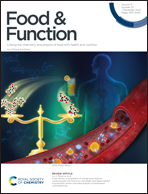Cyclo-(Phe-Tyr) reduces cerebral ischemia/reperfusion-induced blood–brain barrier dysfunction through regulation of autophagy†
Abstract
Cerebral ischemia/reperfusion (I/R) injury is the result of ischemic stroke, a serious threat to public health. I/R injury can damage the blood–brain barrier (BBB), adversely affecting the brain environment and aggravating the injury. Cyclo-(Phe-Tyr) (sparganin C, SC) is a small molecule derived from the Chinese yam Dioscorea opposita Thunb. or Sparganii rhizoma. In our previous study, SC mitigates I/R injury both in vivo and in vitro through the action of JUNB and SOX5. However, the exact pharmacological effects of SC on BBB protection after an I/R injury remain unclear. We constructed a rat model of middle cerebral artery occlusion–reperfusion (MCAO/R) injury to evaluate the therapeutic actions of SC, and the integrity of the BBB was evaluated by ELISA, western blotting, and Evans blue staining. It was found that SC significantly reduced the amount of Evans blue staining in the brain, inhibited the expression of inflammatory factors IL-6, IL-1β, IL-17, IL-23, and TNF-α as well as TIPM1/MMP proteins, and promoted the expression of the tight junction proteins occludin, ZO-1, and claudin-5. SC was found to inhibit the excess autophagy induced by I/R injury to protect BBB integrity through the PI3K/AKT/mTOR pathway, and the PI3K inhibitor LY294002 significantly reduced the SC-mediated protection. Overall, this is the first demonstration of the alleviation of BBB damage caused by I/R injury by SC and suggests a potential treatment for the effects of an ischemic stroke.



 Please wait while we load your content...
Please wait while we load your content...